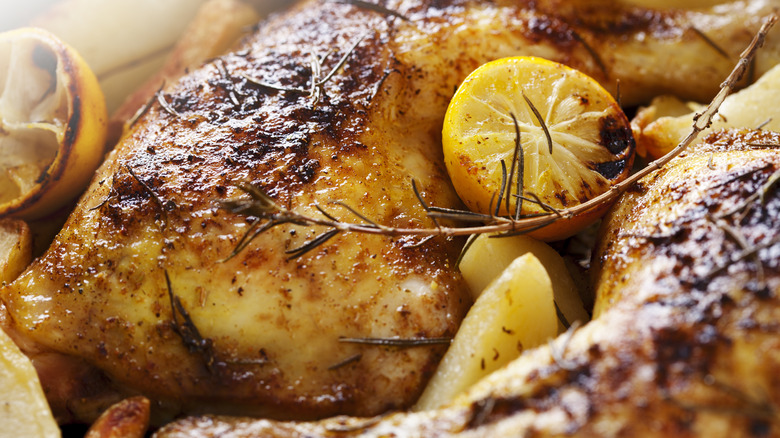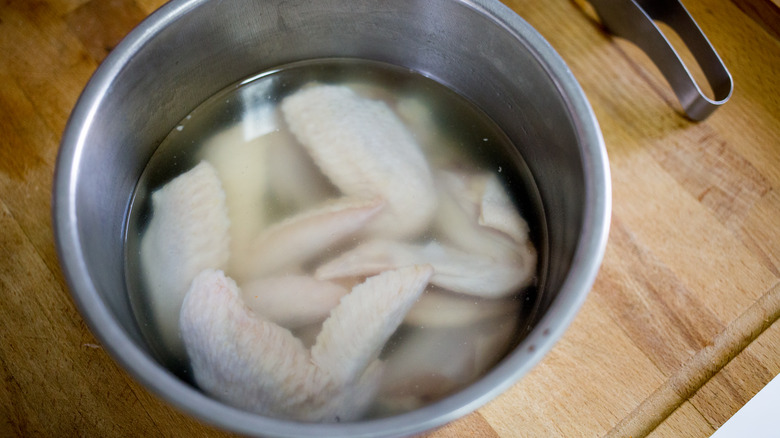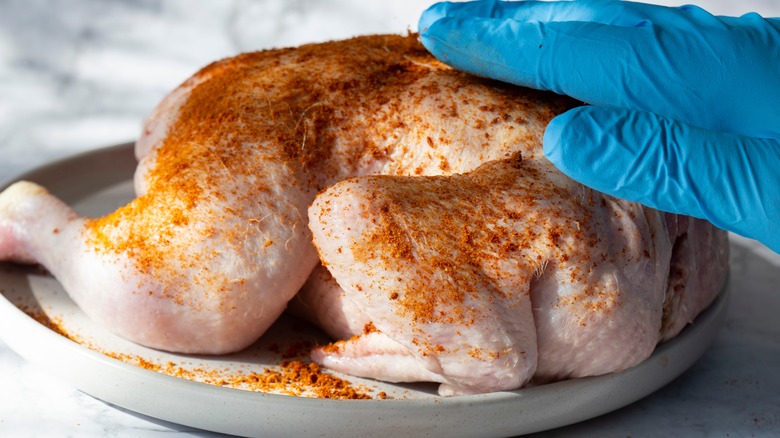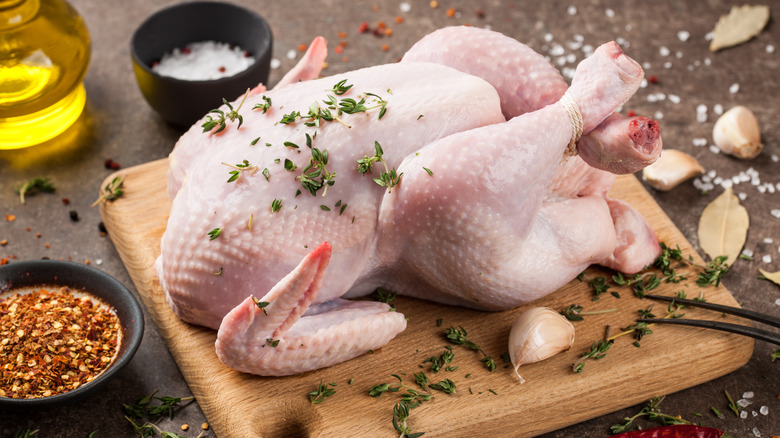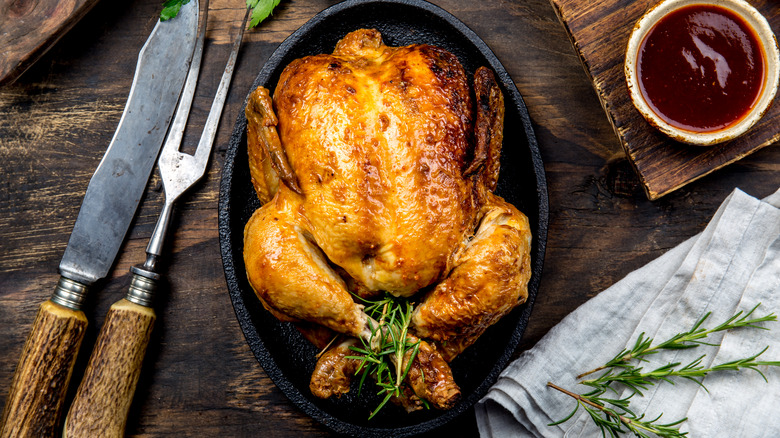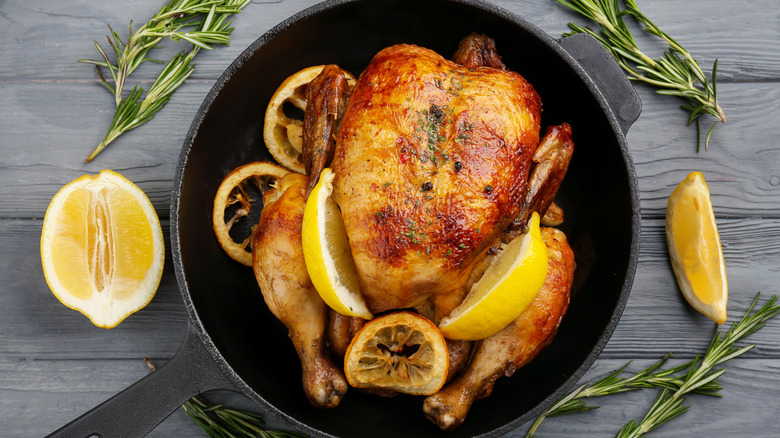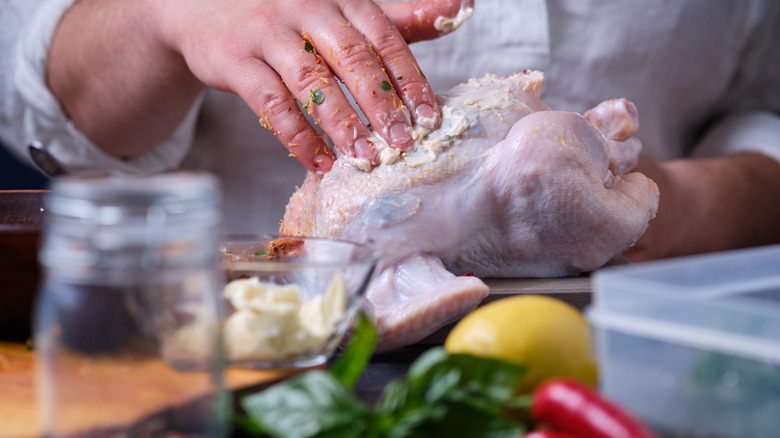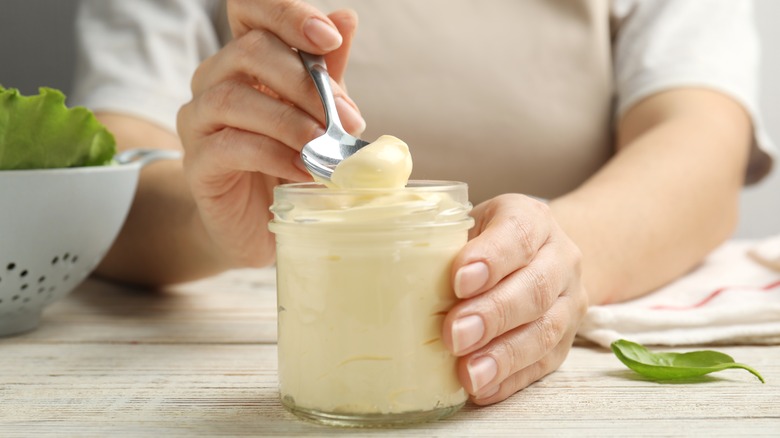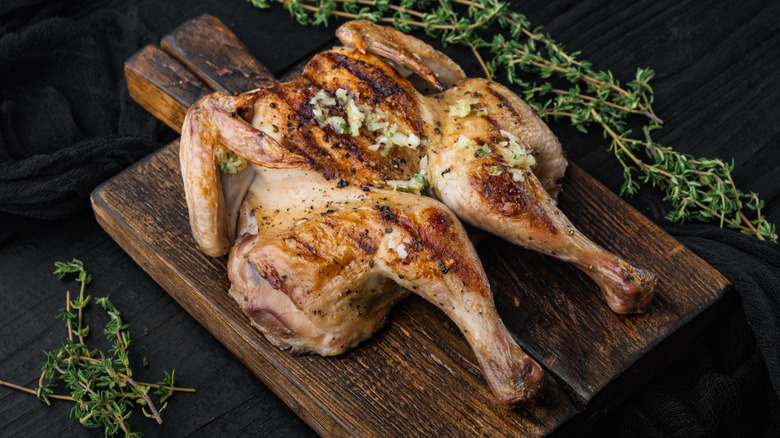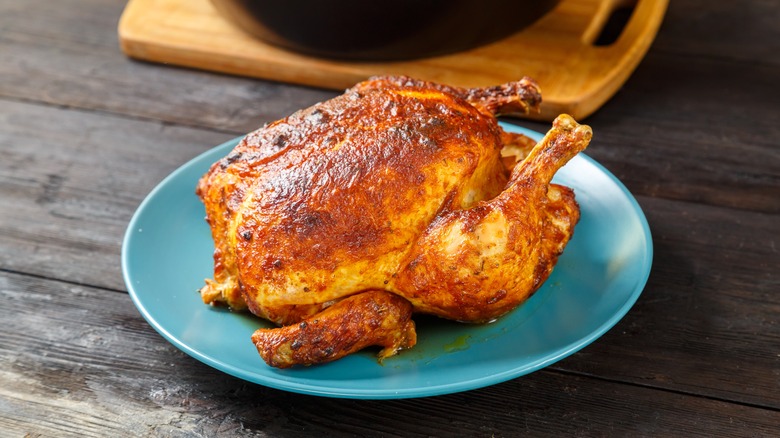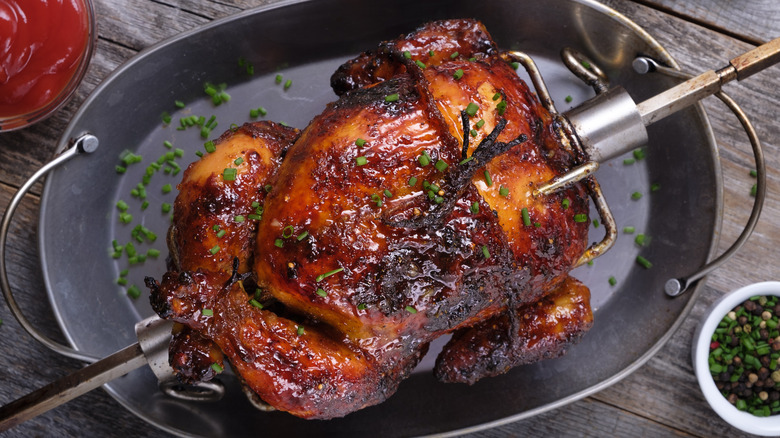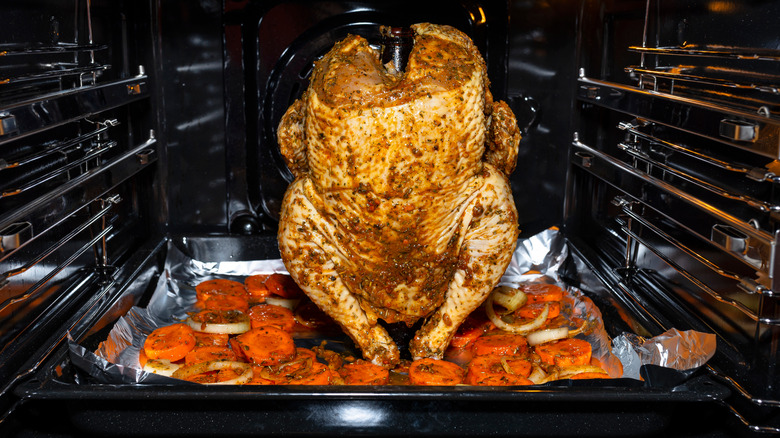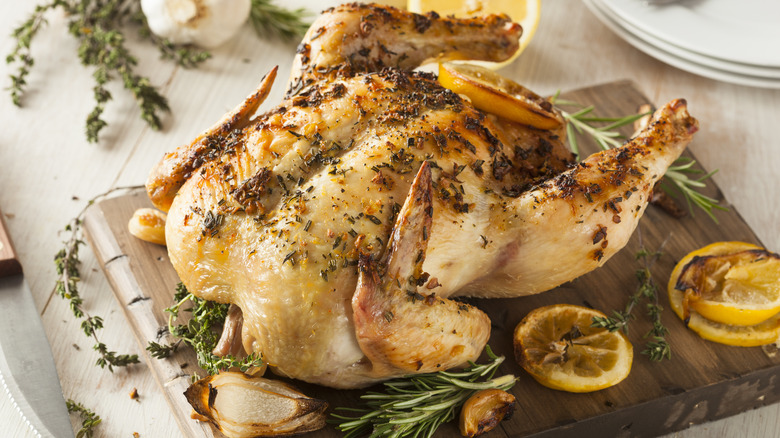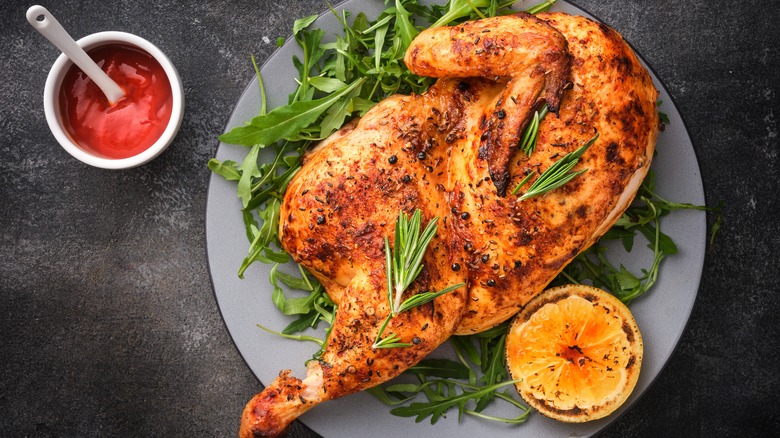13 Ways To Make Roast Chicken Taste Way Better
Hearty, homey, and comforting, roast chicken is one of those foods that hits every note. Versatile chicken can be prepared in so many ways and all of them are tasty — frying, poaching, grilling, you name it — but there's something about roasting that brings out the best in this bird. A perfectly roasted chicken offers browned crispy skin over moist and tender white and dark meat. While on the surface it's a simple dish, it's not always easy to make sure your chicken is properly cooked and packed with flavor.
Here, we've put together a few tips that will help you get the most out of your roast chicken. While these apply to roasting a whole chicken, many of the same techniques can be used with individual pieces of chicken, too. From simple prep hacks to cooking techniques to flavor boosters, keep these helpful pointers in mind the next time you're in the mood to throw a bird in the oven to maximize its texture and taste.
1. Brine, or dry brine, well before cooking
Arguably the most important step to ensuring your roast chicken is flavorful is seasoning it with salt. The two most effective ways of salting meat are brining and dry-brining. These are similar concepts, and each has its pros and cons. Whichever you choose, you'll end up with evenly, thoroughly seasoned chicken.
To brine chicken, you create a heavily salted liquid — other flavoring elements are optional — and then submerge your chicken in it. This allows the meat to absorb both moisture and salt, leading to a juicy, tasty bird. The main drawback with this method is that too much moisture can be detrimental when cooking and you could end up with limp, soggy skin and mushy meat, especially if you leave it in the brine for too long.
A dry brine simply takes the liquid out of the equation. Instead of submerging your chicken in brine, you cover the chicken in salt and let it rest. During that time, the salt pulls liquid out of the chicken which mixes with the salt and is then reabsorbed by the meat. The effect is the same as liquid brining, but the process does take longer. Without either one of these steps, though, your chicken is likely to be bland and one-dimensional — so don't skip it, and give yourself plenty of time before cooking to allow the salt to do its work.
2. Coat it in a flavorful dry or wet rub
Using dry or wet spice rubs on chicken is a surefire way to boost the flavor of roast chicken. It's easy and convenient, too, particularly if you use a pre-made store bought rub. But if you want more control over the flavor, you can easily put together your own spice rub recipe to personalize it to your taste.
The difference between a dry rub and a wet rub is moisture. When using a dry rub, the spice mix is rubbed as-is, directly onto the surface of the meat. If you add a bit of liquid to it, like oil or water or wine, it becomes a wet rub. This can help the spices adhere to the meat if you're having trouble getting them to stick.
Chicken's mild flavor makes it a fun canvas to experiment on when it comes to flavors, and spice rubs are one of the best ways to do that. A classic rub like this one from Dinosaur Bar-B-Que adds a sweet and spicy kick. Remember, if you've already brined or dry-brined your chicken, use a dry rub without salt so you don't end up with an over-seasoned bird.
3. Make sure it's dry and at room temperature before cooking
In order to cook your chicken as evenly as possible, it's important to give it time to temper before you roast it — basically, this means pulling it out of the refrigerator and letting it rise closer to room temperature before placing it in the oven. The timing of this differs based on your chicken, as a larger bird takes longer to temper, and cut pieces won't need much time at all; 20 minutes to an hour is a general guideline.
A properly tempered chicken and a fully pre-heated oven will give you the best chance to cook your poultry perfectly. You don't want one part of the chicken reaching the right temperature while the rest of it isn't ready, as this can lead to some sections of the chicken drying out while others are still partly raw. According to the FDA, 165 degrees Fahrenheit is the internal temperature you want to reach to ensure your chicken is safe to eat.
Dryness is another factor to take into account before roasting. This is especially important if you've marinated or brined your chicken, as it will have been subjected to extra moisture. You don't want that moisture to turn to steam, or your chicken won't crisp and brown. Give it time to drain and pat it thoroughly with paper towels before you stick it in the hot oven.
4. Stuff the cavity with aromatics
The cavity in the middle of a whole chicken is really just an empty vessel for extra flavor. Filling it with traditional stuffings, such as those that include bread and other ingredients like meat or seafood, can be risky when it comes to foorborne illnesss, as the stuffing ingredients may not reach safe temperatures at the same rate as the chicken. While those savory stuffings are unquestionably delicious, they can easily be cooked in separate containers to avoid the possibility of contamination. And that leaves the chicken cavity free for aromatics, which really imbue the meat with flavor.
The term aromatics in cooking refers to a wide range of ingredients from three main categories: vegetables, herbs, and spices. Combinations of these ingredients cooked together are what create flavor depth and dimension in recipes. Garlic is a common aromatic, as are all kinds of onions like leeks and shallots. Whole or ground spices, fresh or dried herbs can all be placed in the chicken's cavity, and as it roasts, their flavors will deepen and release, bathing the chicken in aromas from the inside out.
You can go the simple route with garlic, rosemary, and thyme, as in this classic Whole Roasted Chicken recipe. Or add hot chiles for a kick. Fill it with whole spices like cumin seeds, cardamom pods, and cloves for an intensely warm and flavorful roast. Anything goes.
5. Citrus, citrus, citrus
Citrus and chicken are a perfect pair. In addition to herbs and spices, citrus is another ingredient that's great to stuff in the chicken's cavity before roasting. The combination of the released juices from the fruits' flesh and the oils from the peels infuse the chicken with zesty aromas and bright flavors. Lemon is commonly used, but you can use orange for more sweetness, lime for more tang, or even grapefruit for a zippy bitter quality.
Experimenting with unique types of citrus like yuzu, pomelo, and tangerine will give your chicken different characteristics, and mixing and matching these fruits with other aromatics is a great way to discover new flavor combinations. Try lime with sharp ingredients like ginger and lemongrass, or orange with warm baking spices like cinnamon, clove, and star anise. Roasting softens and deepens the citrus fruits' flavor, letting it balance out the chicken's savory notes without overpowering it.
Citrus zest can also be added to wet and dry rubs, and citrus juice to marinades. Be careful of the juice, however, as its acidity naturally tenderizes the surface of the chicken. Over time, it'll break down the meat's surface too much, giving it an unpleasant texture. Try not to exceed a few hours if you've got a significant citrus juice component in your chicken marinade.
6. Rub butter under the skin
Butter makes everything better, including roast chicken. With its satisfying fat and silky sweet flavor, butter is an excellent ingredient to use both on its own or as a vessel for other elements like herbs and spices. Once butter is softened, it's easy to mix with just about anything, and can then be rubbed all over the chicken before cooking. Spice blends, mined fresh herbs, chopped garlic, hot sauce — any flavors you want to add to your chicken can be added in the form of butter.
While you can rub butter on the exterior of the chicken, you'll get better results spreading it between the meat and the skin. The trick is to slowly insert your fingers in between, moving them carefully to separate the skin without tearing it. Then go back in with your butter and distribute it as evenly as you can across the surface of the meat, putting the skin back in place when you're done. As the chicken roasts, the butter underneath will melt into the meat, imbuing it with flavor and keeping it moist. This process especially helps keep the breast from becoming dried out. Try this recipe for Butter Herb Roast Chicken to see the delicious effects of this technique.
7. Marinate it in mayo
If you use either a wet rub with oil or a butter spread on your chicken, you're already using fat to add texture and flavor. But there's another fat out there to consider using instead: mayonnaise. When you think of mayo and chicken together, you likely don't think of the substance as a coating or marinade — it's for spreading on sandwiches and mixing into chicken salad dressing. As a marinating tool, however, it's incredibly effective at keeping roast chicken juicy and flavorful.
Mayonnaise is an emulsion created from the interplay of oil and egg, with the addition of acidity usually in the form of vinegar or lemon juice. Because of its thick, goopy texture, it sticks to the chicken's surface well. Its fat content adds richness and moisture to the chicken, especially the leaner breast meat which can often dry out during cooking. In the oven, it reacts with heat to create a beautifully crispy exterior. Mix it with other condiments or sauces to add even more flavor, like mustard, soy sauce, or hot sauce.
8. Spatchcock the bird
You may have seen a spatchcocked chicken and wondered what happened to the bird. It looks like a chicken that's been flattened with its drumsticks smushed together. While it might strike you as strange looking at first, the technique of spatchcocking, also known as butterflying, a chicken has a very good purpose. Changing the shape of the chicken means it will roast faster and cook more evenly, and since most of the skin faces up, you'll get more crispiness.
The process for spatchcocking a chicken seems intimidating, but it only takes a few steps. Ensuring you have a good, sharp pair of shears and it's fairly simple. Use them to remove the backbone, then flip the chicken and spread it open, smashing down on it to break the breastbone so it can lie as flat as possible. That's it — your chicken is spatchcocked.
With a spatchcocked chicken, there's no longer a cavity to stuff with aromatics, but you can still add flavoring in any of the other ways mentioned — spice rubs, butter rubs, brining, and marinades. There's no shortage of flavor in this Spatchcocked Chicken with Truffle Butter and Mushrooms.
9. Make it spicy
If your roast chicken isn't taking your taste buds for a ride, there's an easy fix — make it spicy. Whether you're a hot chile head or a newbie who's just dipping a toe in the world of spicy hot food, there's a way to give your roast chicken just the right kick for your palate without going overboard (or underboard, if you're one of the hot ones).
Of course, everyone is familiar with buffalo chicken wings, but you don't need to pigeonhole buffalo style to just one cut. A whole roasted chicken can be done buffalo style, too. There are a few ways to do it: You can douse the chicken in buffalo-style sauce before and/or after roasting, or make a buffalo sauce butter mixture to rub under the skin. Or combine the techniques for an extra fiery bird.
Of course, buffalo is just one style of spice. Any type of hot sauce can be mixed with butter to make a rub with a kick. Fresh chile peppers from mellow poblanos to intense habaneros can be thrown in the chicken cavity, marinade, or butter mixture. And of course, any dry or wet rub can be heated up with spices like cayenne pepper.
10. Give it a glaze
A beautifully glazed and glossy chicken is a sight to behold. But getting a glaze just right can be a tough technique to master. A glaze applied too early can easily burn, especially if it includes sweet ingredients, as sugar caramelizes in heat and can end up making your chicken blackened and bitter. A glaze can be too thin, in which case it won't stick to the chicken and is hardly a glaze at all — or it can be too thick and sticky. But a glazed chicken roasted just right is hard to beat, in both the looks and flavor departments.
A glaze can be made of anything you want, really, as long as the ingredients can reduce to a syrup-like texture — sauces like soy, hoisin, or balsamic vinegar work well, as do sweet items like honey and maple syrup. Wine and stock can be added for dimension, which will reduce as you let the glaze simmer so that you can create the ideal consistency.
The best order of operations is to start roasting the chicken in the oven, and then work on your glaze in the meantime. Toward the end of roasting time, when the chicken is almost ready to come out, brush the reduced glaze on the bird and let it finish cooking. This lets the glaze set, but doesn't give it enough time to burn.
11. Roast it with a beer can
The cavity in a whole chicken is useful (as we've mentioned) for filling with aromatics to add flavor. But it can also be utilized for another cooking technique: beer can chicken. This rather unique process for cooking a whole chicken can be done on a grill, but it's a little easier to keep the temperature consistent and monitored in an oven. It's a simple premise — you take a half-full can of beer, place the cavity of an uncooked chicken on top of it, then roast the chicken upright on the can. In theory, the beer inside the can heats up and infuses the chicken with its flavor and moisture as it roasts.
In practice, while some people swear by this method, there's not really data to support that the beer does much of anything. An experiment by ThermoWorks showed that as the beer evaporated from the can, juices from the chicken dripped into it, so there was no real transference of moisture. However, the vertical positioning of the chicken atop the beer can does make a difference. With more skin exposed to circulating heat, you'll get a more thoroughly crispy exterior and an evenly cooked bird. And while science may not support the miraculousness of this technique, it's hard to deny that it produces a succulent, juicy roast chicken.
12. Garnish it with fresh herbs
Cooking with fresh herbs can be a bit of a minefield. While some herbs take well to long cooking, others wilt and lose flavor after being exposed to too much heat. When you want to add fresh herb flavor to roast chicken, it's important to know which ones are which. Certain hardier herbs like thyme, bay, oregano, and rosemary are tailor-made to roast with your bird, adding flavor complexity as it cooks. Sage is another one that works well, as its robust taste mellows with time in the oven.
But most other fresh herbs will serve your chicken much better if they're added toward the end of cooking, or used as a garnish once the chicken is pulled from the oven and resting. Delicate dill, chervil, basil, and chives should be exposed to as little heat as possible as their fresh flavors quickly dissipate or become less appealing when cooked. Many herbs that can take some cooking, but are also good as fresh garnishes, include tarragon, parsley, and mint.
13. Serve it with a side sauce
So your chicken has been brined, seasoned, and properly roasted — what if you're still yearning for more flavor? Serving roast chicken with a sauce on the side, or a selection of different sauces, can add not only an extra pop of flavor, but more moisture and texture as well. It's also a great option if you're cooking for a group of people who may have different tastes — instead of giving your chicken a spicy glaze or marinade, for example, you can serve an array of hot sauces on the side so people can adjust their chicken to match their heat preferences.
Other sauces that add nice flavor dimension to chicken include bright, fresh herb-based sauces like Chimichurri and Pesto. Another option to give your chicken a Provencal flair is to serve it with rich Garlic Aioli. And of course, a gravy or jus made from pan drippings served alongside is the perfect way to bump up the chicken's natural flavor.
